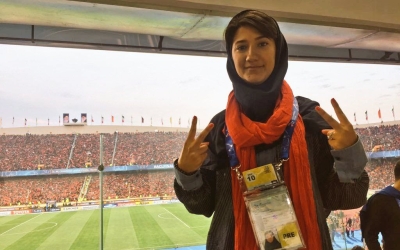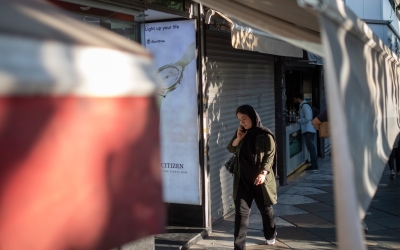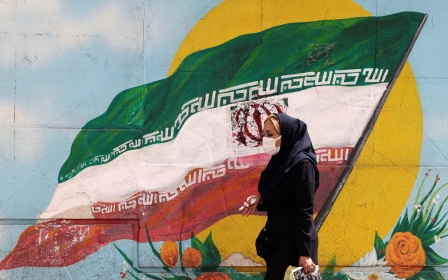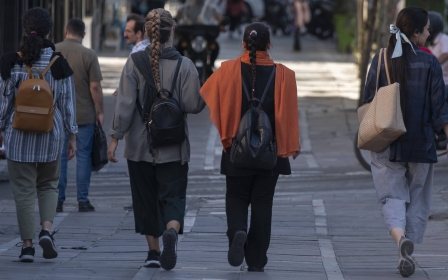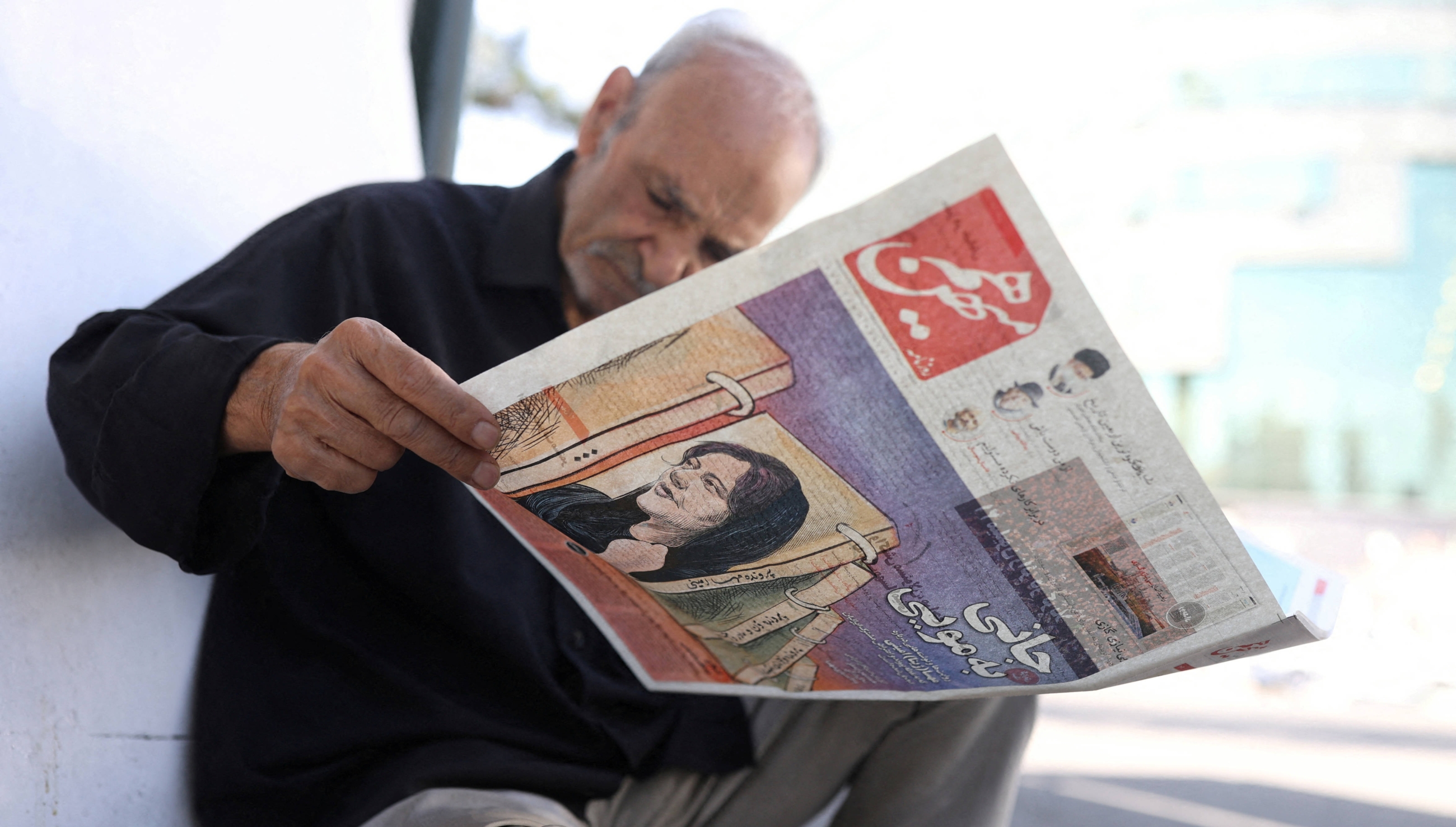
Inside Iran's 'war of attrition' on journalists
Some say it is “like walking in a minefield”, others say it is “like carrying a time bomb”, and 24 years ago being a journalist in Iran was likened to guerrilla warfare.
In over 186 years of Iranian press history - ever since the first newspaper was published in the country on 1 May 1837 - hundreds of journalists have been persecuted and imprisoned.
Some of the most brilliant among them - such as Mirza Jahangir Khan, Sheikh Ahmad Rouhi, Mohammad Farokhi Yazdi, and Khosrow Golesorkhi - were killed during the Qajar (1789-1925) and Pahlavi (1925-1979) dynasties.
However, the decades following the 1979 Islamic Revolution have witnessed new levels of persecution.
Between 1979 and 2009, at least 860 journalists were arrested, prosecuted, imprisoned, and, in some cases executed, according to a Reporters Without Borders (RSF) report in 2019, based on information in a leaked Iranian justice department digital file.
New MEE newsletter: Jerusalem Dispatch
Sign up to get the latest insights and analysis on Israel-Palestine, alongside Turkey Unpacked and other MEE newsletters
But to the surprise of the state, its campaign to pressure journalists into compliance has failed to intimidate the press into silence. And, when the most significant anti-government protests that the country had seen in decades took place last year, Iranian journalists were ready.
Now the establishment is making sure they pay.
Earlier this week, in an alarming development, Iran's minister of Islamic culture, Mohammad Mehdi Esmaeili, floated the idea of imposing a work certificate mandate on all active journalists, which could see their permits revoked.
But this proposal is only the latest salvo in the government's long and increasingly brutal campaign to muzzle the free press in Iran.
Warfare on journalism
On a cold February day in 1999, in the basement of the press department of Iran's culture ministry, Ahmad Bourghani tendered his resignation as press deputy to the then minister of culture, Ataollah Mohajerani.
In his resignation speech that day - in what would become an iconic remark among Iranian journalists - Bourghani drew parallels between the lifespan of a press deputy in office and that of a guerrilla fighter: “Around six months.”
He was referring to the leftist armed movement that fought against the Shah's dictatorial monarchy before the 1979 revolution.
At the time, those who wanted to join the guerrilla movement were told that after six months, they would either be killed or arrested, which commonly meant being tortured to death.
After serving 16 months in his position, Bourghani resigned, primarily in protest against the repeated shuttering of reformist dailies by the ultra-conservative judicial system and parliament's decision to enact a more restrictive media law, but also due to frustration with Mohajerani's tepid support.
That day, when it was Mohajerani's turn to speak, the minister, who was forced to resign a year later after surviving an impeachment vote, flatly rejected his deputy’s assertion, saying the field of culture and journalism was not a place of guerrilla warfare.
But back then, those journalists who were close to the reformists in power - alongside a number of officials as well - were all struck by Bourghani’s words, which left an impression that has lasted to this day.
'You suffer to death'
Today, a veteran Iranian journalist, who was the social editor of several pro-reformist dailies between 1997 and 2005, recalled Bourghani’s speech. But said they thought the famous metaphor - spoken by a member of the political elite - did not fully depict a reality that was in fact much worse for ordinary journalists.
"In guerrilla warfare, fighters have a chance to carry out attacks and counter-attacks, but journalism in Iran is like trench warfare in World War I, a kind of attrition warfare,” he told Middle East Eye.
'You never know when it's your time to hear the security forces banging at your door in the middle of the night'
- Veteran Iranian journalist
“There is no immediate death in it, but you suffer to death," added the journalist, who, like other journalists interviewed for this piece, asked for anonymity for fear of reprisal.
"Moreover, Bourghani was a member of the inner circle of the Islamic Republic. How could he know about the acute suffering of independent journalists?
“And if he complained about his own situation, imagine what journalists had gone through.”
Before being appointed as press deputy, Bourghani was the director of the War Press Office during the Iran–Iraq War, chief news editor at the state news agency IRNA, and the UN correspondent for IRNA.
After he resigned from the culture ministry, he remained in the inner circle of power and was elected to represent Tehran in parliament.
As politicians have switched seats and positions, and power has switched hands between principlists and reformists over the past two decades, the veteran journalist has managed to survive in an environment increasingly hostile to the press.
“During these years, I have seen many fellow journalists arrested and jailed. Many others have changed jobs due to unending bans and arrests or left the country and began a life in exile,” the journalist said.
“Working and living under these pressures is not easy. The authorities' red lines change overnight when they face political or economic turmoil.
“So, you never know when it's your time to hear the security forces banging at your door in the middle of the night.”
'A ticking bomb in your pocket'
Over the past two decades, Mehdi Afrouzmanesh, a 45-year-old journalist, has covered the 1999 student uprising, the 2009 Green Movement, and the 2017 and 2019 anti-government protests.
But, according to him, the situation for journalists became significantly worse when they came to cover the protests that swept Iran following the death of Mahsa Amini in police custody on 16 September 2022, and the violent crackdown on demonstrators that followed.
“These days, being a journalist is worse than walking in a minefield because, in a minefield, there are [ways] to discover and dismantle the mines,” Afrouzmanesh wrote in an editorial for the pro-reformist Hammihan daily on 6 February, when journalist Elnaz Mohammadi was arrested.
“What is happening to journalists nowadays is akin to implanting time bombs in their pockets, which can go off at any moment. It is not just a rhetorical comparison but a real threat.
“Yesterday the bomb in Elnaz's pocket went off.”
Since last September, over 100 journalists have been arrested in Iran, the Syndicate of Tehran Province’s Journalists reported in March, with many receiving long prison terms, like sports journalist Ehsan Pirbornash.
In January, a lower court handed Pirbornash an 18-year prison sentence on accusations of “propaganda against the establishment”, “encouraging the public to shed blood”, and “blasphemy”.
Just a few weeks earlier, another journalist, Aria Jafari, was also struck with a harsh sentence, this time by a branch of the Islamic Revolutionary Court.
The award-winning photojournalist was sentenced to seven years in prison, 72 floggings, and a two-year ban from leaving the country.
The authorities exerted this backbreaking pressure on journalists just as it did on protesters in the streets.
The brutal crackdown on demonstrators by security forces, the police, and the Islamic Revolutionary Guard Corps (IRGC) left at least 500 dead, thousands wounded, and over 20,000 people detained.
The authorities' campaign to curtail critical media put the country at the bottom of the World Press Freedom Index, with Iran ranking 177th out of 180 countries in May 2023.
Many journalists who spoke to MEE underlined that the pressure from security forces, arrests, and imprisonments are just part of the difficulties they face under a repressive regime.
Last nail in the coffin
Smoking on the balcony of a state daily in August last year, a month before protests engulfed the country, a 62-year-old journalist reflected on 26 years of working across different newspapers.
“I've experienced more than enough, moving in and out of reformist dailies, and now I am looking forward to retiring,” he said, as he took a long drag from a cigarette.
“My teeth are in awful condition, and the treatment is so expensive, but if I retire, my health insurance will cover the expenses.”
Many Iranian journalists have suffered from job insecurity due to the judiciary, which is controlled by ultra-right ayatollahs, and the continuous banning of critical media.
At the same time, journalists working in such outlets have had to work for salaries that are, at times, lower than the minimum wage - as well as deal with late and overdue payments after the government imposed new tax laws that cut financial support to critical media.
'What is happening to journalists nowadays is akin to implanting time bombs in their pockets, which can go off at any moment'
- Mehdi Afrouzmanesh, journalist
In January, when President Ebrahim Raisi submitted a draft of the annual budget bill to parliament, journalists realised that the government had decided to remove a law that exempted the media from tax.
In the same bill, a generous budget increase was given to the police, security forces, Basij paramilitaries, and intelligence organisations.
Journalists decried the new regulation, saying it would kill off independent media outlets that were already struggling desperately to survive.
In response - in an apparent gesture of support for freedom of speech - parliament announced that legislators had rejected the note in the budget bill.
However, on 1 May, the Khorasan daily revealed that advertisers in newspapers and news sites would still not be exempted from taxes, a move that would slash outlets' revenue streams.
"In the new Iranian year, the press experienced a big sudden shock that will add to its recent economic issues and push many [outlets] to the verge of shutdown," wrote the Khorasan daily, one of Raisi’s main supporters, even before his victory in the unchallenged 2021 presidential elections.
Trench warfare
A news editor working for a pro-reform outlet in Tehran described the move as “a clear declaration of war on journalists who challenged Raisi, his government, and security forces during the months that the entire country was on fire with the anti-establishment demonstrations”.
According to the editor, despite years of oppression, non-state-run outlets had demonstrated a robust and influential role in informing Iranians about what had happened to Amini, the execution of four protesters, the raids on university campuses, and the arrests of activists, journalists, and lawyers.
“I think the establishment did not expect such a brave and well-thought response by the press inside Iran,” he said.
“The authorities were somehow sure that after years of censorship, putting journalists in prison, and silencing dissidents, they had successfully castrated local media.”
The editor suggested that the media response to the crackdown on the 2022 protests is a result of over two decades of gaining experience in what the veteran journalist had dubbed "trench warfare".
However, he added that surviving the new economic hardships would be extremely challenging for journalists following years of oppressive measures by the judiciary and the security forces.
"Now, what can suffocate the critical media is a government-made economic crisis," the editor said.
'Censorship has different faces'
Iran has a long history of imposing financial burdens on the media and silencing the voices that challenge its rulers.
One of the darkest moments in this long campaign took place in March 2019 under former president Hassan Rouhani, when his government removed paper subsidies for newspapers.
'The authorities were somehow sure that after years of censorship, putting journalists in prison, and silencing dissidents, they had successfully castrated local media'
- Iranian news editor
After the two-week Nowruz holiday, the two leading pro-reformist newspapers, Etemad and Shargh, were forced to reduce their number of pages to half due to the soaring prices of imported paper.
That same year, even state-run papers, Iran and Hamshahri, were affected by this economic pressure, and 70 journalists from the latter’s newsroom, and 70 workers from its publication house were sacked. The Iran daily also laid off 23 employees.
A pro-reformist journalist, who stopped working in Iran after the 2009 clampdown on the Green Movement and the closure of several newspapers, believes that the financial stress put on the media in Iran should be seen as a form of censorship.
“Censorship has different faces, and one of those is implemented through economic means,” said the former journalist, who now works for a transportation company in Australia.
“Arresting journalists and banning dailies give the authorities a bad reputation, so what is the other way to kill critical outlets? What’s better than economic hardship?
“With this strategy, no one would blame the authorities for the closure of independent media.”
Asked not to return
This policy has been remarkably successful in recent years.
Since the 2022 demonstrations began, various economic pressures have been exerted on journalists. Many journalists - even in state-run outlets - who supported the protests have lost their jobs or were suspended.
“Where I work, I could not write anything about the demonstrations or the arrest and killing of the protesters, so I posted the news that I had on social media,” a journalist who worked on a state-run website told MEE.
“Then, one day in November, I was asked to go to the HR office and told that I’d been suspended from my position for a month because of my social media posts.
“A month later, when I returned to work, I had to sign a commitment letter saying that my posts on social media would comply with the laws of the Islamic Republic of Iran.”
Others, however, were less lucky and a number of journalists have been fired for what they wrote on Farsi social media.
Mohammad Ajorlou, a sports journalist who had worked at the state news agency IRNA for 13 years, was one of them.
Ajorlou's wife, Niloofar Hamedi, the Shargh Daily journalist who first reported on Amini’s hospitalisation and death, was arrested on 21 September.
Since then, Ajorlou has shared on Twitter the latest information about his wife's detention, and the arrest of other journalists and dissidents.
In January, Ajorlou was asked not to return to the office and to work online instead. A month later, IRNA informed him that his annual contract would not be extended after March, and just like that, he lost his job.
Another journalist, Elaheh Mohammedi, who worked for the Hammihan newspaper, was arrested following her reporting of Amini’s funeral.
Hamedi and Mohammadi are still in prison, despite a year-long campaign by international NGOs and organisations.
On 3 May, they and rights activist Narges Mohammadi were named as the laureates of the 2023 Unesco's Guillermo Cano World Press Freedom Prize.
'Bullets and gallows'
Over the past year, international bodies such as the Committee to Protect Journalists (CPJ), the International Federation of Journalists, and Reporters Without Borders have made several demands for the release of Hamedi and Mohammadi from pre-trial detention.
Members of these organisations told MEE that Iranian authorities have made it impossible for international NGOs to support journalists in prison.
They added that Iranian authorities do not respond to their requests and correspondences.
“We strongly want to assist as much as we can and more than what we are doing now, but in the case of Iran, what we can do is very limited,” said Yeganeh Rezaian, a senior researcher at US-based CPJ.
“First of all, Iran doesn't have an embassy in the United States, so we cannot meet with Iranian officials in person and bring up issues related to journalists.
“Moreover, Iranian officials never issue visas for our advocacy team to visit the Iranian journalists and talk about their issues face-to-face.”
Rezaian, who was held in Tehran's infamous Evin prison for 72 days in 2014 while working as a journalist in Iran, said that other repressive governments, like Russia and China, or even the Taliban in Afghanistan, at least held meetings with CPJ representatives to talk about these issues.
“No matter how many emails or faxes you send or phone calls you make, you will never receive a response from Iranian officials,” she added.
“It is like a black hole, and each time hardliners come to power in the country, the situation deteriorates.”
Rezaeian explained that Iran’s delegation to the United Nations is the only official entity that the CPJ can contact for the release of detained journalists and demand respect for freedom of speech in the country.
“But they are absolutely non-responsive, which makes them the most difficult officials to deal with,” she said.
Journalists in Iran also told MEE that international organisations cannot help them in their fight against imprisonment, forced confessions, and state censorship.
“What can they do in response to a governing system whose answer to any criticism is bullets and gallows?” said an Iranian journalist in Tehran.
“All they can do is make the world hear about what is happening to us, and nothing more than that.
“If I was detained, I would want that. At least, the world would know my name.”
Middle East Eye delivers independent and unrivalled coverage and analysis of the Middle East, North Africa and beyond. To learn more about republishing this content and the associated fees, please fill out this form. More about MEE can be found here.



